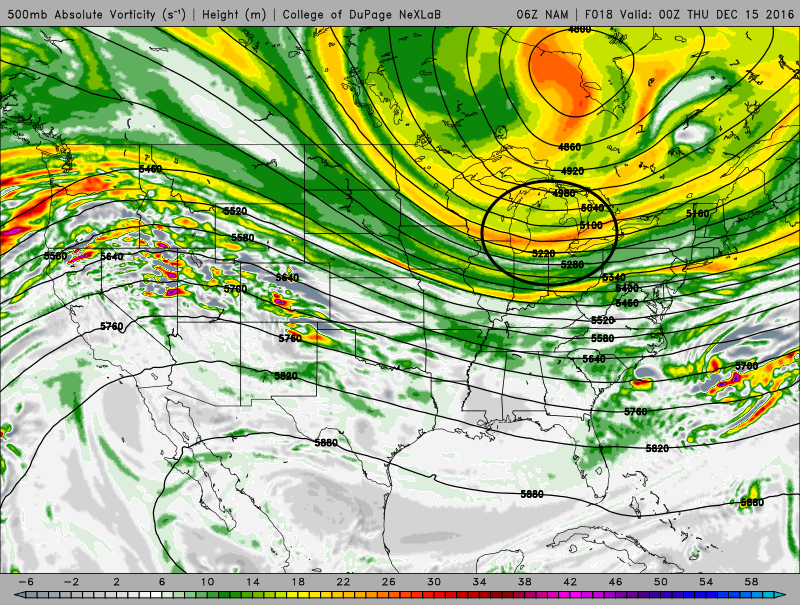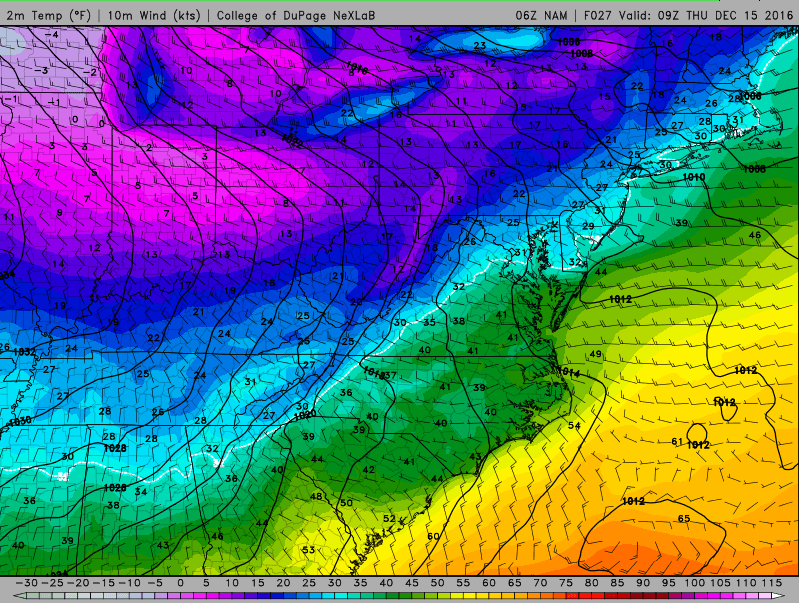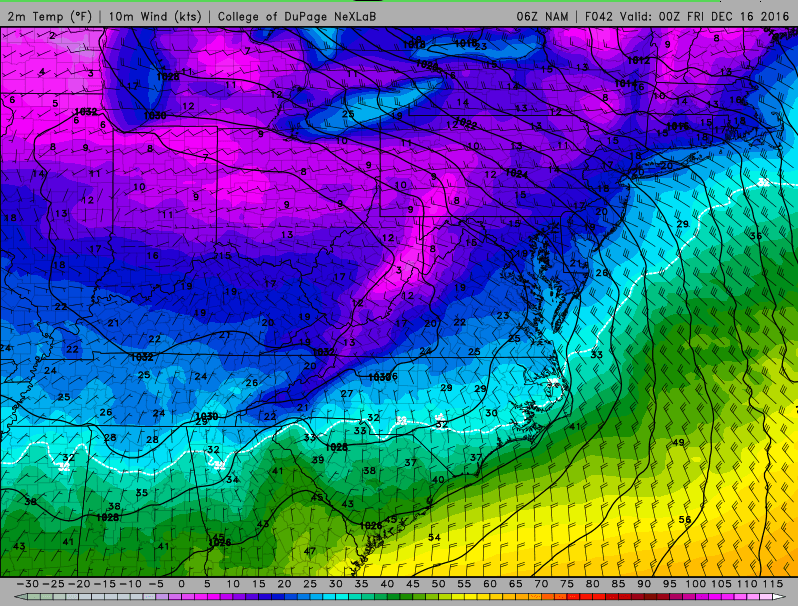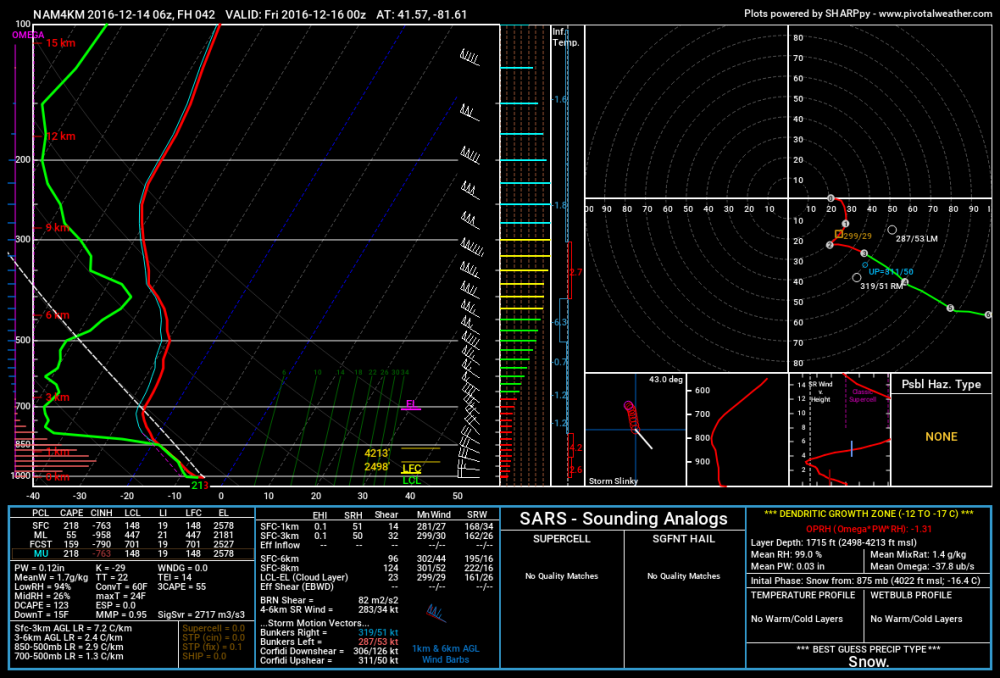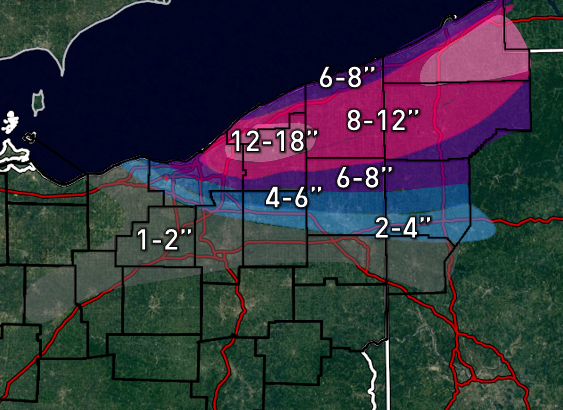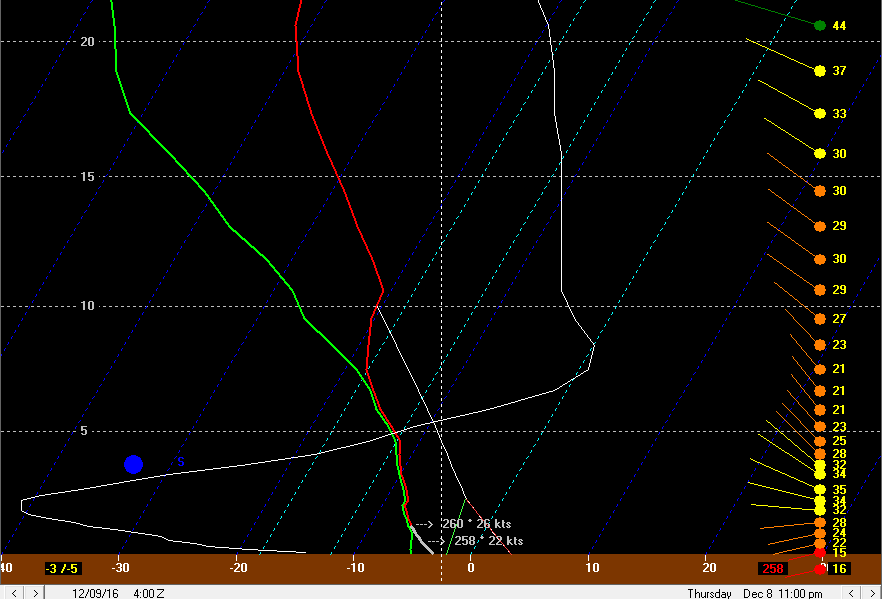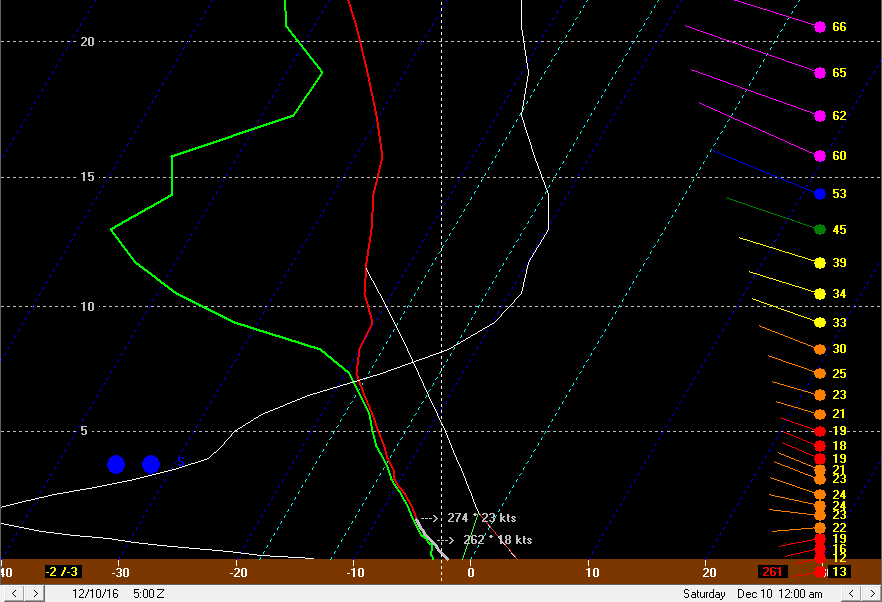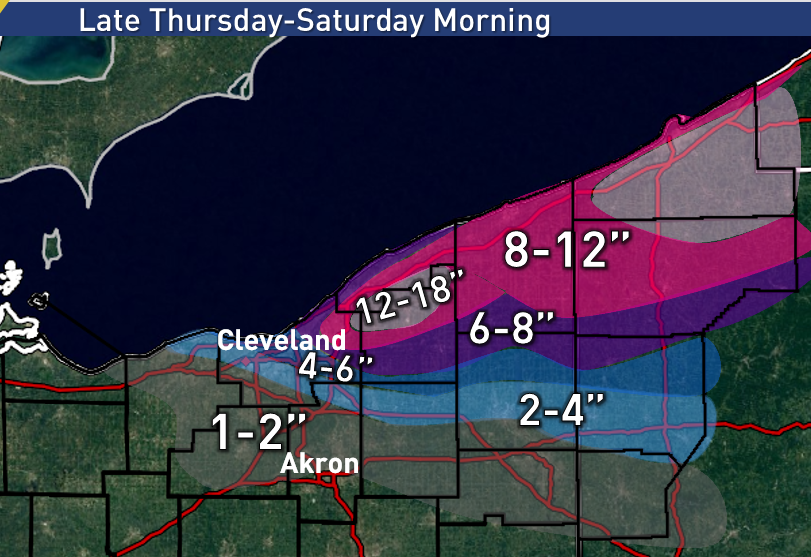
OHweather
Meteorologist-
Posts
4,981 -
Joined
-
Last visited
Content Type
Profiles
Blogs
Forums
American Weather
Media Demo
Store
Gallery
Everything posted by OHweather
-
I think the trend for Cuyahoga started a couple of winters ago...there was one point where they'd throw the whole county an advisory bone when a small part of it may get 3-5", and have certainly backed off of that recently. There are pros and cons to both ways of doing things (county average vs county max snowfall)...my general feeling is you can't not warn people who will see heavy snow for the sake of not warning people who won't see snow. If it's a situation where a small part of the county may squeak out a certain criteria and the vast majority won't, I'm ok with forgoing the headline, but if it's even a quarter of the county I think it justifies the headline. Impact is important too...is the rest of the county seeing 3" at 2am or during rush hour? Last weekend's event really only affected about a quarter of the county with warning criteria snow, but I think everyone agrees that not issuing the warning would've been ridiculous. I think the ultimate solution is breaking Cuyahoga County into multiple forecast zones (which will not happen) or lake effect snow advisory/warning polygons (which probably will happen).
-
Pretty good signs for a band across Cuyahoga during the AM rush. Spots will probably hit warning criteria anyways and this looks like a potential high impact event...so I don't agree with CLE only going with an advisory. The AFD wasn't much help either.
-
An unseasonably deep upper level trough will drop into Ontario and Quebec through Friday, ushering in the coldest air of the season thus far and aligning the winds out of the west-northwest across the Great Lakes, setting off another round of heavy lake effect snow. Lake effect snow will intensify this afternoon as winds go southwesterly and allow a strong single band to form over the lake towards Buffalo. The flow is somewhat sheared, however an increase in moisture and lift ahead of a shortwave rotating around the upper level trough and moderate instability developing over the lake should allow snow rates of over 1” per hour to develop with the band as it moves off the eastern end of the lake this afternoon into locations near and just south of Buffalo. The aforementioned shortwave will move over Lake Erie and NE Ohio/NW PA/SW NY between 0z-6z/7pm-1am Wednesday evening and push winds to a more WNW direction. As this shortwave approaches, even colder arctic air will move in allowing instability to decrease, while at the same time inversion heights come up. A connection to Lake Michigan will likely develop and larger scale lift from this first shortwave and another one will help enhance lake effect processes Wednesday evening through Thursday morning. Instability will increase this evening, with lake to 850mb temp differentials increasing to 22C+, lake to 700mb temp differentials increasing to 32C+, and lake to 500mb temp differentials increasing to 40-42C. These values are all extreme and along with equilibrium levels on the models of over 10k feet suggest any snow band will be very intense and likely accompanied by some sporadic lighting. The combination of some moisture from the shortwave trough and a connection to southern Lake Michigan will increase moisture depth to around 8k feet. Snow ratios should be fantastic tonight with good RH and strong lift focused on the DGZ. Winds are a little bit on the strong side, but a very well aligned flow, upstream connections, and a favorable long fetch with a W to WNW flow and good convergence along the shoreline should mitigate the stronger winds. The first trough this evening doesn’t have appear to enough oomph to push inland, so the band may get locked in or move very little for several hours late this evening into early Thursday morning. With rising pressure over the Ohio Valley and very cold, dry air inland along with WSW winds, this band will likely setup near or along the lakeshore and into the primary Snowbelt. This wind profile is fairly similar to the one that locked in a band along route 6 with the last event, although with somewhat stronger WNW winds over water, which may allow the band to set up a couple of miles farther south tonight. This could bring downtown Cleveland, the immediate western lakeshore, more of eastern Cuyahoga County and more of southern Geauga County into play tonight. I don’t expect a huge difference in placement from the last event, but that couple of miles could make a big difference to some heavily populated areas that were on the edge of the last event. The winds wiggle a little bit between late this evening and Thursday morning, but not a ton, so the convergence near the lakeshore and fairly steady winds should cause the band to drift over similar areas for most of the night tonight. The next shortwave and surface trough will push SE across the lake between 5am and 10am Thursday morning. There appears to be a somewhat stronger push of NW winds behind this trough, so it will likely push the snow band inland before perhaps breaking it up into multi-bands for a time later Thursday morning. The environment will be very favorable for heavy lake effect snow as this second trough passes; wind shear will be minimal, although wind speeds again are maybe 5-10 knots faster than is preferable. Lake to 850mb temp differentials are expected to exceed 25C by Thursday morning, with 700mb differentials exceeding 35C. These are both incredible differentials driven by the arctic airmass moving over a still somewhat warmer than average lake, with lift from the shortwave and an upstream connection to Lake Michigan offsetting the drier arctic airmass. The trough will likely push through quickly enough that the band doesn’t sit on any one spot for more than a couple hours (although we’ll have to watch and make sure it doesn’t get hung up just inland), however the instability/moisture profile combined with the minimal wind shear, strong lift and good RH in the DGZ, and very strong convergence expected between 10kt WSW winds south of the trough and 30kt WNW to NW winds over the water north of the trough, suggests that very heavy snowfall is expected. Instantaneous snowfall rates to 2 to 4” per hours seem likely should this band come to fruition, however it’s questionable how long these rates sit over any one spot. The bad news is this band looks to move across a good portion of the Cleveland metro near rush hour, and even if those snow rates don’t last long they can create quite a mess. Behind the trough Thursday morning, winds are expected to go WNW to even NW, and this should push the primary band inland and break it up into multi-bands for at least a few hours. This will likely spread some lighter accumulations into the secondary Snowbelt and give a break to the northern primary Snowbelt. This flow could bring upper Great Lake connections (perhaps Superior/Michigan) into NW PA, and also hits the upslope areas well there, so moderate accumulations could continue in NW PA behind this trough in the higher terrain, with activity tapering considerable near and north of I-90. The Lake Michigan connection should shift south of Lake Erie for a few hours later Thursday morning and early afternoon in the more WNW to NW flow, although it’s possible upslope in the central highlands allows for a period of snow showers as the Lake Michigan connection aims towards that general area. Some negatives will develop behind this second trough; the fetch will become shorter and the airmass will dry out, both due to the upstream airmass becoming even drier and the Lake Michigan connection shifting south. This drier airmass, shorter fetch, and somewhat colder temperatures will likely make it hard for intense bands to develop. Outside of any intense bands, it will be cold enough to limit snow growth and hence keep ratios in check. So, accumulations could really slow down for a time later Thursday morning into the afternoon. If a heavier multi-band can set up, then latent heat release within the band may push the DGZ into the clouds and allow for locally higher ratios within any band; due to the flow though it may be a struggle to see good bands develop for a time on Thursday. The surface high will really start pushing in Thursday evening, allowing temps to crater over land to near 0 and also causing SWrly winds to develop on land. This will tighten up convergence again near the lakeshore and in the Snowbelt, and may also re-develop a Lake Michigan connection for a time: This combination of renewed convergence and some improved low level moisture could allow a band to re-develop from northern Cuyahoga County east into southern Lake and Geauga Counties Thursday evening. Winds will slowly continue to back as high pressure noses in, so this should cause the band to slowly shift northeast through the night. With that said, the winds on land may not get strong enough to push the band completely over the lake until Friday morning. Forecast soundings from within the potential snow band on hi-res models show inversion heights remaining near 700mb through Thursday evening before really dropping off, with good moisture and lift (omega) in the DGZ. This could allow a decent band to still produce 1-2” per hour snow rates for a time Thursday evening closer to the lake. With that said, inversions do crash later Thursday night and high pressure will try pushing the band north, so amounts Thursday night will likely be held to less than 6” where the band is more persistent, and much of that could fall during the first half of the night. So, as for amounts…it is quite possible that the lakeshore from eastern Lake County east through Erie County struggle to see a ton with this one. I expect a good burst in the primary Snowbelt from northern Cuyahoga County east/north as the single band pushes onshore with the first trough tonight. With convergence quite possibly hanging close to the lake and into the Snowbelt tonight behind the first trough, along with a Lake Michigan connection and very favorable conditions for heavy lake effect snow, it seems possible that a heavy band with 1-2” per hour snow rates persists for several hours tonight. With WNW winds over water, it is possible this band affects the lakeshore in Cuyahoga County before moving inland into the eastern suburbs, southern Lake County and a good portion of Geauga County. With a long fetch into the higher terrain of NW PA, those areas may do decently too. The band may wiggle some, which if it occurred may keep amounts through 5AM Thursday in the 4-8” neighborhood where the band affects most…however, if the strong convergence causes the band to be more impervious to small wind direction changes, the band locking in and producing up to a foot by 5AM Thursday isn’t impossible in a small area. I expect the snow to intensify across the board between 5-9AM Thursday as the next trough passes through. Snow rates could increase to 2-4” per hour in the dominant band. This band will probably initially intensify in the northern Snowbelt before slipping south through 9AM Thursday and quite possibly breaking up into multi-bands late Thursday morning as the winds go WNW to NW. This band may move quickly enough that it only drops 1 to 4” of snow as it goes, but this could affect parts of Lorain, much of Cuyahoga, southern Lake, much of Geauga, southern Ashtabula, parts of NW PA (inland especially), and perhaps even northern Medina, Summit, Portage, and Trumbull with a burst of very heavy snow during rush hour. This could be a very high impact event. If the band gets hung up somewhere at all, even for just 2 or 3 hours, the very heavy snow rates could allow it to quickly drop over half a foot over a narrow corridor. This may happen from the western lakeshore into SE Cuyahoga County for a time, due to the winds paralleling the shoreline there for a time and perhaps causing the convergence to “stick” to the lakeshore for a couple of hours. The snow should diminish across the board late Thursday morning and into the afternoon. The instability suggests heavy squalls may still occur, but the snow bands will likely break up by then, and the colder/drier arctic air may stunt snow growth outside of any good bands. Some areas, such as the higher terrain in the secondary Snowbelt, Geauga County, and particularly NW PA may pick up 1-2” late Thursday morning and afternoon, but unless we get a band to hang on from the west side into say Medina/Summit Counties…which does sometimes occur with this type of flow, but is hard to predict ahead of time…I doubt accumulations will be particularly impressive in this timeframe. Signs do point towards a single band re-developing late Thursday afternoon and into the evening as winds inland turn SW and increase convergence along the lakeshore into the Snowbelt, while a potential Lake Michigan connection also tries to redevelop. Inversion heights will start to lower and moisture will be more limited than say tonight, however intensifying convergence along with weakening winds (increased residence time over the lake) could still allow a decent band to develop for a time. This band may initially develop from the western lakeshore out east towards Chagrin or Solon before gradually moving north. Snow rates of 1” per hour or more may still be supported Thursday late afternoon and evening if we get a good band to develop, but the band will likely be slowly moving, and conditions appear to degrade significantly for lake effect after midnight, so additional amounts from this band will likely be held to 2 to locally 6”. Storm totals may exceed a foot where the band is most persistent tonight into early Thursday, and where the snow band tomorrow evening affects. I doubt amounts exceed 18” due to the bands likely moving around/breaking up at times through the event. I did include decent accumulations on the western lakeshore, as convergence could be strong in that area at times and allow for banding there. The southwest edge is as always not high confidence. Map: Also, I know a couple of you asked me questions yesterday, when I get time today I will try to respond. Was not home until about midnight last night.
-
12z NAM was definitely a bit more encouraging in terms of bringing the winds around to the WNW...we'd definitely get the band to set up farther south if that verified. Hopefully it's a trend and not a one run blip. The GFS consistently brings winds around too far NW with lake effect events so I've started ignoring it lately.
-
This will be an interesting event... Things will initially get going on Wednesday up towards Buffalo with a SWrly flow. The first trough drops across the lake Wednesday mid to late evening and brings the winds around to W or WNW. Given the extremely strong temp gradient between over water and inland, along with higher pressure nosing into the OV, I expect this trough to get hung up near the lakeshore, perhaps close to where the mega band set up with the last event for several hours Friday evening. Mean winds on the NAM look a few degrees more northerly, so maybe it can setup a couple miles farther south, but I sort of doubt that a band sets up over say the Garfield to Solon corridor Wednesday night into Thursday. Although the incoming arctic airmass is characteristically dry, the flow will be very favorable for involving a Lake Michigan connection, and the very well aligned flow over Lake Erie will help any bands be more organized. Instability will also be extreme Wednesday night. Another shortwave/vortmax rotates around the larger trough and moves over Lake Erie/NE OH early Thursday. This will probably briefly add some larger scale lift and could really cause lake effect to rip and rip hard early Thursday. The winds do go more WNW behind this trough on Thursday, but with such cold air inland and higher pressure nosing in I doubt the band sinks south. I could see it setting up a few miles farther south than the last event, but again I have my doubts for how much farther it sets up. If it does set up farther south this could involve the western lakeshore, downtown, and the 480/422 corridors in eastern Cuyahoga County. Not 100% sold on that but it appears more possible than the last event. Ridging noses in Thursday evening which should cause a band to slowly shift north and probably gradually weaken by Friday morning, ending the event as winds turn southerly. As for amounts...definitely think there's potential for 2 to 4" per hour snow rates in the band Wednesday night into Thursday...particularly Thursday morning as the shortwave moves by. This is because of upstream moisture, low shear, and some of the most prolific instability I've ever seen over Lake Erie with temperatures this cold. The airmass will be on the cusp of being "too cold" for great ratios, but with such warm waters I'd have to imaging a good band would easily push the DGZ right up into the cloud layer. Ratios of 30-40:1 seem likely. With a band possibly locking in or moving very slowly Wednesday night, amounts of over a foot could occur by Thursday morning. If the band locks in for most of the night, amounts overnight could exceed 18". On Thursday the band may wiggle south and similar snow rates may continue for a good chunk of the day. If this occurs, those who miss out Wednesday night could get a nice consolation. If the high pressure and extreme cold over land cause the band to struggle to move south, then some areas could double dip (again) and see a very impressive total. We shall see what happens, still some time to adjust.
-
Thanks for the measurements!! Held on to snow here until almost midnight, mixing with sleet now. Roughly 5" of snow so far. Had wet snow with fairly large flakes for a few hours this evening that added up nicely.
-
I'm going to make a map of observed snowfall from this lake effect event based on reports and radar. If any of you have amounts to report from NE OH or NW PA that you haven't posted already, please do post them so I can include them. The January 17-19th event last winter also had a swath of 2 foot totals in a similar area as this event...although I believe this event had a larger 2'+ area east of Cleveland and had higher max amounts...still trying to figure out if anyone officially broke 3 feet. I'm almost certain a couple spots tickled that number, but a spotter report of it would be nice.
-
Going 3-5" for all of us right now. Nice prolonged overrunning should drop 2-3" for us through early tmr afternoon. After that we are on the cusp of dry slot and mixing issues. Any further trend south is huge for us. We are riding knife's edge..:should see snow but the back half of the storm could make or break it in terms of bigger amounts.
-
32.8" in Kirtland so far! The radar estimated bullseye is actually a couple miles west-southwest of that spotter, so it's possible the true jackpot is along route 6 just west of Kirtland, or perhaps between route 6 and Wilson-Mills, and may be a little higher than that.
-
I figured about 2 feet of snow there. Didn't bring a ruler because this was one of those "hey what are you doing after work" type get togethers with myself and my friend with all wheel drive. I'm not sure if they can get 8 or 10 more inches and push 3 feet but it'll be close in a spot or two if this band doesn't move much overnight.
-
Poking around southern Lake County...jumped out of the car between Kirtland and Willoughby Hills and the snow was a couple inches past my knees. I'm 6'5" tall
-
23" 4 miles SW of Kirtland as of 9pm!!
-
Finally. Good snow into Cleveland proper, most of the east side, and down towards the NEO/dta area. I'm sure lakeeffect in Chesterland will have a huge total if he checks in. Someone near the Lake/Geauga/Cuyahoga county triple point should end up with 2 feet or so.
-
Wow, saw a report of 14.4" 4SW of Kirtland as of 3pm. Whoever got hit cleaned house. 12z euro was a widespread 6-8" over the weekend btw.
-
I'm optimistic now. This band tonight was well advertised and I like that it's forming over northern Lorain and more of Cuyahoga.
-
Some lightning strikes near Euclid off and on with this band
-
Reports suggest northern Geauga and southern Lake were at 6-8" as of early this morning, with parts of Ashtabula pushing 6" and parts of Erie County seeing a good bit more. Some of those areas are sitting under bands and are doing really well. The bust on the SW edge is looking rather inevitable now and is rather frustrating. Hard to figure why winds never came around to WNW. I suppose there's still a window for that but it's shrinking. Winds over the lake and in the heart of the Snowbelt appear to be WNW but we just can't get that to push any farther south. Euro keeps us all snow with that system and would be 4-8"...tough call on that one, I expect us to change to rain at some point, but the antecedent airmass is cold enough that it will take time and a decent thump could occur ahead of the changeover. I like a few inches for northern OH but that has time to be adjusted.
-
Did you drive north of route 6? Radar estimated over half an inch of liquid there over night (with a sharp cutoff to the south) so I'd hope those areas saw a decent amount at least. I think the WSW surface flow may have hurt Cuyahoga, as that pushes convergence north of the shoreline there and over the lake...so I'm hoping that changes later this morning. The trough was expected to push through earlier, but surface winds are still SW on land and it looks like there's a trough over the lake still. Getting winds at the surface to shift would decrease shear and also shift the bands farther southwest so that is what we need to hope for.
-
The trough still hasn't pushed through, and bands often move north just ahead of a trough so that may be what happened. Snow had gotten into more of the eastern suburbs but pulled out an hour or two ago. It's a little bit odd to see WNW to ESE oriented bands in the snowbelt but nothing into Cuyahoga County...may have something to do with shear which appears to have done a little more dirty work than I thought. . Winds should still gain a more northerly component and shear decrease some by later this morning/early this afternoon, so things should still shift farther southwest. This does decrease the chances of someone on the southwestern edge of things getting lucky and getting way more than forecast. The heart of the snowbelt will probably do fine with amounts because it's been snowing there all night, but we'll see what happens farther west...still have into this evening to get snow there.
-
I highly doubt we get banding as far south as the HRRR shows, but feel pretty good no one will have issues getting expected amounts. We will see where the SW cutoff ends up at.
-
An unseasonably deep trough will move across the Great Lakes Thursday through Saturday, bringing with it a deep cold air mass, sufficient moisture, and a broad cyclonic flow across the warmer than average Great Lakes. This will result in the second lake effect snow event downwind of Lake Erie of the season. This one will be of longer duration, favor lighter winds, a longer fetch, and colder temperatures, likely resulting in much more substantial totals than the first one (2-6” in NE OH). As the cyclonic flow begins developing over the region Thursday morning, a band of snow will likely develop over the lake and hug the lakeshore in Lake and Ashtabula Counties, before moving into Erie County PA and Chautauqua/Cattaraugus County NY. The band will likely hug the north half of those counties. We’ll actually be in a region of subsidence with mid-level drying through early Thursday afternoon behind a shortwave trough moving over the region early Thursday morning, however the long fetch and moderate instability will likely allow decent accums to being across parts of NW PA/SW NY on Thursday with this band. By Thursday evening, a weaker shortwave or vort max is expected to drop across Lake Erie between 5-10PM. This will cause inversions to rise and mid-level moisture to increase, while also bringing a surface trough and wind shift with it. The winds will shift from WSW in the low levels to more of a W Thursday evening as this trough pushes through. This will likely push heavier snow into the NE OH lakeshore Thursday evening and push it a bit farther inland of NW PA and SW NY. With the passage of this first trough, inversion heights will increase to around 10k feet and moisture depth will increase to around 8k feet, allowing the intensity of the lake effect to increase: Although the shear looks bad, it’s much better aligned over the lake, and will result in strong convergence near the lakeshore as stronger, W to WNW winds over the lake run into weaker WSW winds over land. The stronger WNW winds over water will try to push the snow inland some Thursday evening, however the WSW winds over land suggest the better snow will hug extreme NE Cuyahoga County, Lake County, Geauga County along and north of US 6, the northern half of Ashtabula County and into Erie County through Thursday evening. The instability and moisture support snow rates of over 1” per hour assuming convergence can develop as it appears it should and focus better snow in the aforementioned area. The 12km NAM does show this zone of convergence, extending from as far west as Lorain County into inland Erie County PA, with the convergence stronger farther east. This favors moderate to heavy snow in the northern NE OH primary Snowbelt and into a good chunk of Erie County PA (and also the ski-country in SW NY) Thursday night. The convergence will not move much for several hours, so several inches could be picked up in these areas Thursday evening into the overnight, with locally over 8” in NW PA/SW NY through 4am Friday where a longer fetch, more terrain, and seemingly stronger convergence could contribute to heavier snow. Between 4am and 10am Friday, another shortwave will rotate around the larger trough to our northeast. Although the upper level shortwave stays to our northeast, the surface reflection will move southeast across Lake Erie as a well-defined trough. This will initially really increase convergence along the lakeshore early Friday as winds back a little bit on land ahead of the trough, and turn more WNW to even NW over the lake behind the trough. The upper level support for this surface trough will stay to our northeast, and the surface trough will be moving into high pressure nosing into the Ohio Valley, so it’s questionable how quickly this trough pushes through. Regardless of how quickly the trough pushes through Friday morning, conditions for lake effect will go from “pretty good” to “pretty outstanding” Friday morning, with moisture depth improving to 10k feet, inversions rising to 13-15k feet, and winds in the low levels weakening a little bit and increasing residence time over the lake. Lake to 850mb, 700mb, and 500mb differentials will push or exceed 20C, 30C, and 40C Friday morning as the trough pushes through…all of these values are “extreme” and support a few lightning strikes with any good snow bands Friday morning near the lake. Snow rates of 2” per hour are quite possible with the band along the surface trough Friday morning. The question is, how quickly does the trough and band push south? I suspect the heart of the primary Snowbelt…far NE Cuyahoga, southern Lake, northern Geauga…will see a few hours of very good snow ahead of and along this trough given the W to slightly S of due W wind direction ahead of the trough. From there, winds only go WNW behind the trough, with the best upper support remaining well NE, and with surface ridging nosing into the Ohio Valley. This suggests that the trough will not push south super-fast, and may not push the snow band farther south than northern Lorain County/southern Cuyahoga County/the Geauga/Portage County border. This may drop a quick 1-4” on much of the Cleveland metro as well as southern Geauga County, inland Ashtabula County, and southern Erie/most of Crawford County PA given likely intense snow rates and gradual progression of the trough and accompanying snow band. Behind the trough for late Friday morning and afternoon, shear is weak, the flow is a favorable WNW and not too strong, instability remains extreme with high inversion heights, and moisture depth remains respectable. Decent lake effect snow should continue. The big questions for Friday behind the trough will be whether some sort of band can maintain itself across the southern Snowbelt and allow for a more focused area of moderate to heavy snow, and whether or not we can get any upstream connections. The environment is pretty freakin good for lake effect snow on Friday, so it’s just a matter of capitalizing on it: The WNW low level flow does suggest a continued connection off of southern Lake Michigan through the day Friday, which would suggest some decent snow in the Cleveland metro and primary Snowbelt in NE OH. This flow would take the Lake Superior connection (which is actually rather common) into NW PA. The 850mb flow is a bit more NWrly and takes the southern Lake MI connection south of Lake Erie and takes the upper lakes connection into the Cleveland metro and Snowbelt. The well aligned low level flow off of lower Lake MI and some convergence along the way suggests that connection may contribute to snow in the Cleveland metro on Friday, with upstream lakes keeping things going in NW PA/far SW NY during the day behind the trough. Convergence will probably weaken some Friday with an absence of a trough to our NW, and also with temps on land warming up some and decreasing the temp differential over the lake a little bit. Regardless, remnant convergence from the morning band and some remaining lake to land temp and wind differentials should allow some loosely organized snow to persist on Friday across the Cleveland metro and southern Snowbelt. I don’t expect a firehose band, but with such a good thermodynamic profile and some pre-seeding from Lake Michigan there could be good bursts that add up to at least a couple to few inches during the day Friday behind the trough. This will be the best chance for parts of Lorain, Medina, Summit, Portage, southern Trumbull and Mahoning Counties (particularly northern portions of this corridor) to see some accumulation. A good question is how much of a break will the northern primary Snowbelt see on Friday during the late morning and afternoon. In NW PA and SW NY, there doesn’t look to be strong convergence, but there may be decent connections to Lake Huron and Lakes Superior/Michigan (northern). This may cause snow to shut off along the shore (outside of any upstream connections) but decent snow could keep going in the higher terrain, particularly in any upstream connections. In NE OH, I expect northern Ashtabula and Lake Counties to see snow really slow down and possibly shut off Friday late morning and afternoon…however, convergence and orographic lift just inland may allow at least snow showers to continue in far southern Lake County, Geauga County, and southern Ashtabula County in the higher terrain…though they may become less organized. This may support a few inches behind the trough in the higher terrain of Erie and northern Crawford County in NW PA and a couple inches in far southern Lake County/northern Geauga County in NE OH through Friday afternoon…with perhaps a few inches a little farther south in NE OH where convergence tries to persist. There may be an interesting setup Friday night into Saturday morning as ridging builds closer and slowly backs winds. There is pretty good agreement on a good southern Lake Michigan connection developing Friday evening, with the potential for strong convergence developing near the central lakeshore as temps cool on land and as winds on and go light and southwesterly: This could favor a more organized convergence band re-developing Friday evening and persisting into Saturday morning. With a W or WNW wind initially, this band could initially develop over northern Cuyahoga and central Geauga County before slowly shifting north later Friday night into Saturday morning. Conditions will remain favorable for decent LES through Friday night before degrading Saturday morning: Upper level temps warm a little bit, but the low and mid levels remain plenty unstable and moisture Friday night for heavy snow rates should a band form. Any upstream connection would only increase the likelihood of heavy snow Friday night, and the somewhat weaker low level flow may also favor heavyier snow. Winds suggest this band will shift to northeastern Lake, northern Ashtabula, and Erie PA counties by sunrise Saturday. Snow rates of 1-2” per hour may be possible under this band, with the potential for the band to persist long enough to drop a few or locally several inches Friday night. Winds should shift enough to finally push the band out of Erie County PA by mid to late Saturday afternoon, bringing this event to a close. As for accumulations…I expect 2-6” through mid Thursday afternoon in northern Erie County PA and into northern Chautauqua/Cattaraugus County NY with a WSW flow band that should start developing by morning and become fairly intense by afternoon. Coastal Lake and Ashtabula Counties may see a light accumulation from this. By Thursday evening I expect the snow to intensify and push a bit farther south, and this could produce another few inches (3-6”?) through Thursday evening in Chautauqua/Cattaraugus County NY, Erie County PA and Lake and northern Ashtabula County in OH as the first trough pushes through and winds go more westerly. Far NE Cuyahoga and northern Geauga may also see light accumulations through Thursday evening. These accumulations in NW PA and SW NY should be focused a bit south of where the initial band will dump through mid-afternoon. Thursday evening into the overnight will likely see the band hold steady or shift ever so slightly farther south with a WSW surface flow on land and WNW flow over the lake. Lake effect conditions gradually improve, and this could produce another few inches (2-6”) through 4AM Friday in far NE Cuyahoga, northern Geauga, Lake, northern Ashtabula, and Erie PA (into inland SW NY). The band will intensify ahead of the next trough and then gradually push south into the Cleveland metro and southern Snowbelt. This whole process could produce a few inches in the northern Snowbelt initially while the band intensifies early Friday, and then 1-4” in the southern Snowbelt and Cleveland metro through mid Friday morning as the band swings south. Friday late morning through afternoon may feature the snow becoming less organized…however upstream connections, longer fetch and upslope into NW PA may produce a few more inches in this timeframe, with perhaps a few inches where the remnant convergence band and southern Lake MI connection set up into parts of the Cleveland metro (possibly western and southern suburbs) and southern Snowbelt. The band Friday night may produce a couple inches in eastern Cuyahoga/southern Geauga and up to several inches in northern Geauga and Lake/Ashtabula and into NW PA as it re-flares and then very slowly shifts NE. NW PA may see some more Saturday morning before it finally ends. All together…given the potential for multiple instances of banding with moderate to heavy snow, and perhaps even continued accumulating snow showers between periods of banding, think there will be over a foot in the typical hot spots in southern Lake/northern Geauga and inland NW PA. Inland NW PA may see locally up to 2 feet where any upstream lake connections develop on Friday. Drew the sharp southern cut off from northwestern Cuyahoga County southeast through far northern Summit, northern Portage, and Trumbull Counties. Winds get WNW for a time, but lake aggregate troughing tends to be stronger when the lake is warmer, and ridging building in on land suggests the trough/convergence band Friday may not make it extremely far inland. For the Cleveland metro this is tough…may be a couple of windows for banding near the shoreline late Thursday night through Friday evening which could produce a few inches, even down to the shore. Farther east, there may be a good shot of banding through very early Friday another shot Friday night into early Saturday, so amounts along the shore could be decent. There could be graupel near the lake given how warm the water still is which may hurt ratios near the shore and keep higher amounts inland a bit. Inland could see 15-18:1 ratios with temps below freezing for the event. High res models are iffy on amounts…BUF WRFs look good through early Friday but don’t run out any farther. NMM is similar to this idea but struggles to develop an organized band at times and is lighter on amounts…ARW seems lost. 4km NAM isn’t far off from this idea but also struggles to organize bands and shows lighter precip than you’d expect given the setup, and hence shows much lighter amounts. The 12km NAM and SREF consistently show snow, perhaps in a band, in the Snowbelt, and these low-res models combined with the setup do argued for a prolonged heavy event with good totals in the heart of the Snowbelt. We’ll see. With all of that said...here's my map:
-
Yes, I am done. This would have been finals week had I not been done, so it's more than somewhat possible that I would've been busier at school than I am at home this week...go figure. If I get 2 or 3" I'd be happy...then maybe some synoptic over the weekend.
-
Interesting update. Working so damn much this week but I'm gonna take a good look tonight. Should be a decent event.
-
That CLE map from the AM isn't extremely far off from my thinking. I'll probably post my forecast at the normal time, like 2am
-
Solon and Euclid tend to have fairly reliable spotters, but in between we only occasionally get reports from Shaker, Beachwood, and Mayfield Heights. Those middle 3 are really helpful in these setups if they report. And I'm just hoping for a good winter since I'm here for it, may be out east next winter.

